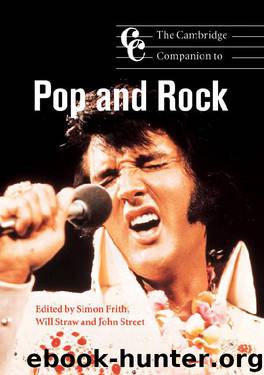The Cambridge Companion to Pop and Rock (Cambridge Companions to Music) by Simon Frith & Will Straw & John Street

Author:Simon Frith & Will Straw & John Street [Frith, Simon & Straw, Will & Street, John]
Language: eng
Format: epub
Publisher: Cambridge University Press
Published: 2001-08-16T03:00:00+00:00
7 Dance music
WILL STRAW
In 1978, the sociologist Richard Peterson suggested that American popular music was on the verge of its third great revolution of the twentieth century. The first two revolutions, Peterson (1978) claimed, had been ushered in by jazz and rock. The beginnings of the third were to be glimpsed in the rise of disco music, which made dance clubs a powerful force in popularising new records. As Peterson made this prediction, disco records sat atop sales charts in Europe and North America, and the disco film Saturday Night Fever was on its way to becoming a major box-office success. Two years later, when much of disco culture appeared to have collapsed, Peterson’s prediction would look like an embarrassing miscalculation. It would take twenty more years, shifts in terminology, and a whole set of technological, social and economic developments before his claim of a dance music ‘revolution’ seemed worth re-considering. In 1997, commemorative books and anniversary dance parties celebrated a decade of frantic dance music activity in Great Britain and Western Europe, amid signs that even white North American youth, long faithful to rock, were migrating towards dance clubs and the sounds of dance music.
Dancing has long occupied an uneasy place within Western popular culture. For centuries, as Ann Wagner’s (1997) study of anti-dance campaigns shows, dancing has been the focus of ongoing controversies about ‘movement, manners and morals’. Dance remains controversial because it offers us two images of human bodies in motion. In one of these, dance represents the triumph of discipline and restraint. Here, as in the aristocratic world of pre-Revolutionary France, dancing is among the most orderly of social rituals, to be learned along with the rules of dining and courtly conversation. In dancing, individuals submerge their identities within gestures and movements which are not of their own making but, rather, handed down by tradition and authority. Teaching the young to dance is thus an effective way of passing on the rules of comportment and etiquette, of moulding the individual into a good, moral citizen.
In a counter-image, dancing is the very model of social disorder. To dance is to resist the restraints of rules and decorum, yielding to passionate impulses which threaten social stability. To many of those who visited the dance halls of the early twentieth century, dance offered a glimpse of social breakdown, in which desires with no useful purpose or virtuous end were given free rein. From this perspective, dance offers the occasion (and even the excuse) for forms of intimacy and physical expression which would not be tolerated in most other contexts. Dance is no longer about learning the rules of good behaviour, but an occasion for violating those rules. It is this image of dancing which has aroused the ire of moral reformers over several centuries, inspiring repressive laws, cautionary pamphlets and claims that dancing is the devil’s work.
In a more modern version of this debate, it is the relationship of dancing to a capitalist economic system which is often in question.
Download
This site does not store any files on its server. We only index and link to content provided by other sites. Please contact the content providers to delete copyright contents if any and email us, we'll remove relevant links or contents immediately.
The Goal (Off-Campus #4) by Elle Kennedy(13213)
Kathy Andrews Collection by Kathy Andrews(11345)
Diary of a Player by Brad Paisley(7272)
What Does This Button Do? by Bruce Dickinson(5938)
Assassin’s Fate by Robin Hobb(5867)
Big Little Lies by Liane Moriarty(5528)
Altered Sensations by David Pantalony(4877)
Pale Blue Dot by Carl Sagan(4632)
Sticky Fingers by Joe Hagan(3918)
The Death of the Heart by Elizabeth Bowen(3350)
The Heroin Diaries by Nikki Sixx(3328)
Beneath These Shadows by Meghan March(3157)
Confessions of a Video Vixen by Karrine Steffans(3109)
The Help by Kathryn Stockett(3024)
How Music Works by David Byrne(2969)
Jam by Jam (epub)(2882)
Harry Potter 4 - Harry Potter and The Goblet of Fire by J.K.Rowling(2818)
Strange Fascination: David Bowie: The Definitive Story by David Buckley(2704)
Petty: The Biography by Warren Zanes(2579)
